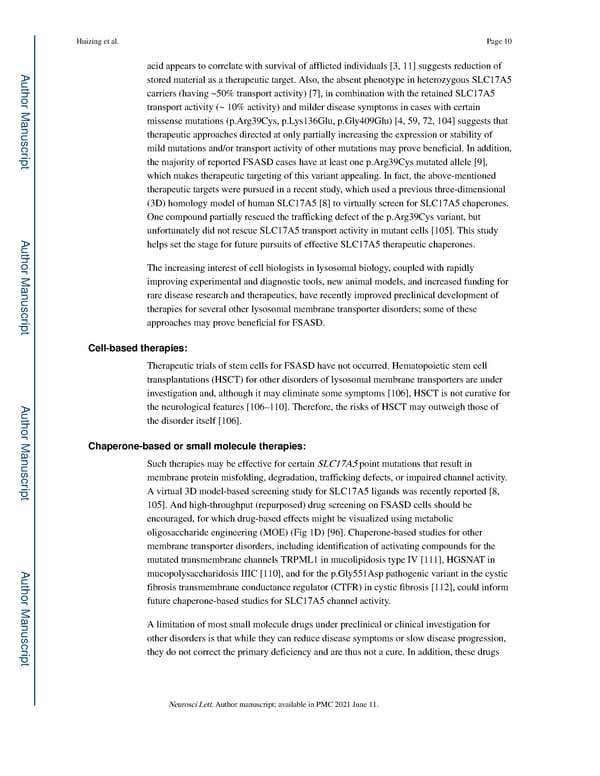Huizing et al. Page 10 acid appears to correlate with survival of afflicted individuals [3, 11] suggests reduction of A uthor Man stored material as a therapeutic target. Also, the absent phenotype in heterozygous SLC17A5 carriers (having ~50% transport activity) [7], in combination with the retained SLC17A5 transport activity (~ 10% activity) and milder disease symptoms in cases with certain missense mutations (p.Arg39Cys, p.Lys136Glu, p.Gly409Glu) [4, 59, 72, 104] suggests that uscr therapeutic approaches directed at only partially increasing the expression or stability of mild mutations and/or transport activity of other mutations may prove beneficial. In addition, ipt the majority of reported FSASD cases have at least one p.Arg39Cys mutated allele [9], which makes therapeutic targeting of this variant appealing. In fact, the above-mentioned therapeutic targets were pursued in a recent study, which used a previous three-dimensional (3D) homology model of human SLC17A5 [8] to virtually screen for SLC17A5 chaperones. One compound partially rescued the trafficking defect of the p.Arg39Cys variant, but unfortunately did not rescue SLC17A5 transport activity in mutant cells [105]. This study A helps set the stage for future pursuits of effective SLC17A5 therapeutic chaperones. uthor Man The increasing interest of cell biologists in lysosomal biology, coupled with rapidly improving experimental and diagnostic tools, new animal models, and increased funding for rare disease research and therapeutics, have recently improved preclinical development of uscr therapies for several other lysosomal membrane transporter disorders; some of these ipt approaches may prove beneficial for FSASD. Cell-based therapies: Therapeutic trials of stem cells for FSASD have not occurred. Hematopoietic stem cell transplantations (HSCT) for other disorders of lysosomal membrane transporters are under investigation and, although it may eliminate some symptoms [106], HSCT is not curative for A the neurological features [106–110]. Therefore, the risks of HSCT may outweigh those of uthor Man the disorder itself [106]. Chaperone-based or small molecule therapies: uscr Such therapies may be effective for certain SLC17A5 point mutations that result in membrane protein misfolding, degradation, trafficking defects, or impaired channel activity. ipt A virtual 3D model-based screening study for SLC17A5 ligands was recently reported [8, 105]. And high-throughput (repurposed) drug screening on FSASD cells should be encouraged, for which drug-based effects might be visualized using metabolic oligosaccharide engineering (MOE) (Fig 1D) [96]. Chaperone-based studies for other membrane transporter disorders, including identification of activating compounds for the mutated transmembrane channels TRPML1 in mucolipidosis type IV [111], HGSNAT in A mucopolysaccharidosis IIIC [110], and for the p.Gly551Asp pathogenic variant in the cystic uthor Man fibrosis transmembrane conductance regulator (CTFR) in cystic fibrosis [112], could inform future chaperone-based studies for SLC17A5 channel activity. A limitation of most small molecule drugs under preclinical or clinical investigation for uscr other disorders is that while they can reduce disease symptoms or slow disease progression, ipt they do not correct the primary deficiency and are thus not a cure. In addition, these drugs Neurosci Lett. Author manuscript; available in PMC 2021 June 11.
 Free Sialic Acid Storage Disorder: Progress and Promise Page 9 Page 11
Free Sialic Acid Storage Disorder: Progress and Promise Page 9 Page 11